#Gromphadorhina portentosa
Text


the cutest little peeled guy in the world wtf
#madagascar hissing cockroach#g. portentosa#Gromphadorhina portentosa#cockroaches#insects#pet insects#arthropods#bugs#hissing cockroach#these are non hybrid g.portentosa from the cleveland zoo line
70 notes
·
View notes
Text
@thrones-of-buer submitted: Sometimes you just need a hug

He pushed the roach off and ignored it. Sometimes you need a hug, but strangers sometimes don't like being touched.
Lol aw. Poor roach was denied a hug. Maybe one of the other roaches will give them a hug :)
#animals#arachnids#submission#scorpion#asian forest scorpion#heterometrus silensus#madagascar hissing cockroach#Gromphadorhina portentosa#cockroach#hissing cockroach#roach
147 notes
·
View notes
Text

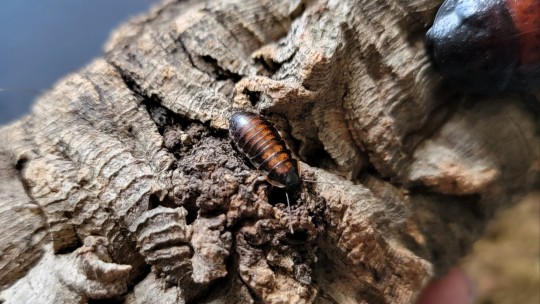
The hissing roach babies have molted 🥰🪳💕
#hissing roach#cockroach#invertblr#madagascar hissing cockroach#so many!!!#gromphadorhina portentosa
15 notes
·
View notes
Text

So, um, somebody offloaded three Madagascar Hissing Roaches onto me and I don't know what to do with them because we're not supposed to keep pets in the dorm but now it's too late because they're cute and I'm attached?
On an unrelated note I'd like you all to meet my new roommate. Her name is Betty B. Buggs.
#insect#cockroach#Madagascar hissing cockroach#Gromphadorhina portentosa#insectophobia#Her brothers' names are Bernie and Bobby#if you were curious#I wanted to get a picture of all three at once but handling these little guys is harder than you might think#bug#bugblr
10 notes
·
View notes
Video
Absolute unit of a Madagascar hissing roach
(X) <-
#madagascar hissing cockroach#cockroach#hissing cockroach#roach#insect#insects#gromphadorhina#gromphadorhina portentosa#animal#animals#wildlife#wild animals#nature#video#animal video#animal videos#blaberidae
52 notes
·
View notes
Text
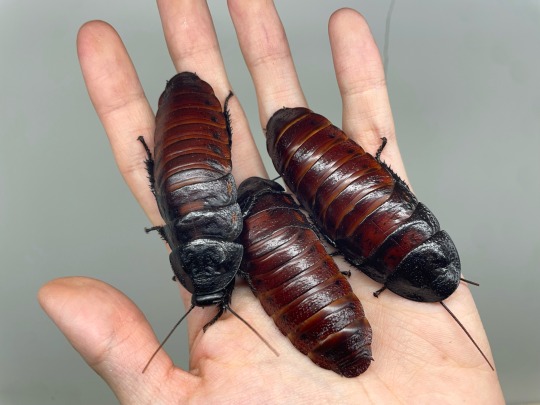
some hissing cockroach appreciation! it only takes three roaches to make a handful
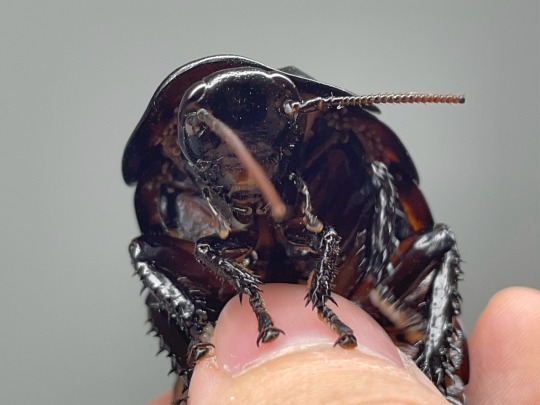
this one was the largest (probably in the whole culture of them) at 13.5 grams!

(Gromphadorhina portentosa x mutts)
1K notes
·
View notes
Photo
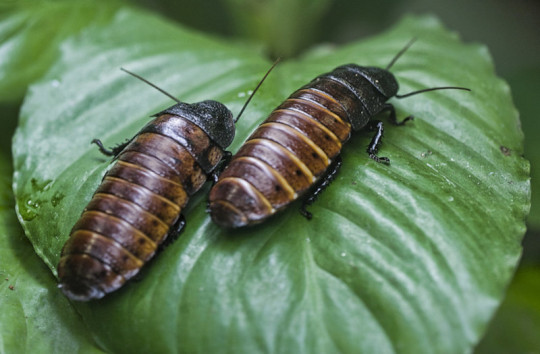

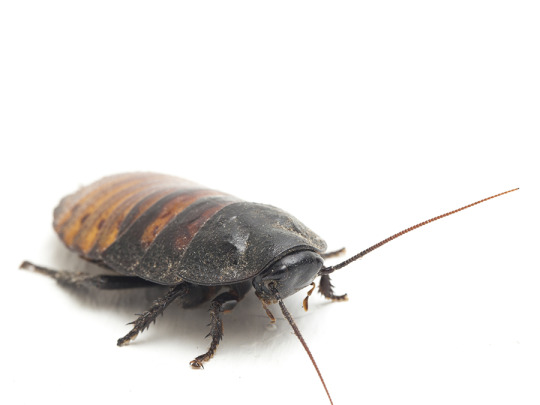
Cozy Up to the Madagascar Hissing Cockroach
One of twenty hissing cockroach species, the Madagascar hissing cockroach or simply the hisser (Gromphadorhina portentosa) is found only on the island of Madagascar. There, it prefers the dry leaf litter and rotting logs of lowland tropical rainforests, though it can also be found in cool, damp, dark areas of buildings. These habitats are ideal as they can offer both refuge from predators like rodents and birds, and food: hissing cockroaches are detritovores, feeding exclusively on decaying plant and animal matter. This makes them important members of the ecosystem as they recycle nutrients back into the soil.
G. portentosa is one of the largest species of cockroach in the world, reaching up to 7 cm (3 in) and 24 g (0.8 oz) when fully grown. Unlike other cockroaches, the hisser lacks wings and travels exclusively over the ground. Fortunately their hard, dark brown exoskeleton provides excellent camoflage against the forest floor. Males and females are nearly identical; the only difference is the pair of horns, or pronatal humps, found just behind the male’s head.
Though they may live in close quarters, madagascar hissing cockroaches are largely individualistic. Males fiercely guard small territories, only leaving occasionally to find food and water. Females and young are somewhat more social, and move in and out of these territories freely. As their name implies, hissers communicate primarily by hissing. This sound is produced by expelling air through their bodies. Four distinct hisses have been identified, each with different meanings; territorial displays, mating calls, and an alarm hiss to warn away predators.
Hissers reproduce all year round, provided the weather is warm enough. Males attract females by hissing loudly, and fight off rival males through hissing competitions and posturing. When a female enters a male’s territory, she emits a chemical to attract a mate. When the pair meet, they enter a brief courtship ritual involving vocalizations and touching each other’s antennae; they then position themselves end to end and remain there for upwards of 30 minutes.
The female will carry her fertilized egg case, or ootheca, for about two months. Up to 40 nymphs will hatch from the case while still inside their mother, who then expells her young all at once. These nymphs resemble adults in structure, but are smaller and lack reproductive organs. Initially they are white, but quickly turn brown or black as they grow, molting about once a month until fully grown. Sexual maturity is reached at about seven months of age, but individuals can live for up to 5 years.
Conservation status: The Madagascar hissing cockroach has not been evaluated by the IUCN, and populations are considered to be stable. In addition, many zoos and private collectors maintain hissing cockroaches for display or food for other animals, as the species is low maintenence and easy to breed in captivity.
If you like what I do, consider leaving a tip or buying me a ko-fi!
Photos
Liz West
Lincoln Park Zoo
Alexandria Zoo
#madagascar hissing cockroach#Blattodea#Blaberidae#hissing cockroaches#cockroaches#insects#arthropods#tropical forests#tropical forest arthropods#tropical rainforests#tropical rainforest arthropods#africa#madagascar#biology#zoology#animal facts
181 notes
·
View notes
Note
hey can i get those five species of cockroaches listed. i was gonna leave it at that but it seems you are a cockroach main so a top 5 list might be more interesting if possible
Omg thanks for asking me about roaches 🥺 and sorry for taking that long to answer your ask but I just couldn't throw a list without at least giving some information about those wonderful little creatures that are cockroaches! I absolutely love roaches, they are so smart, so interesting, so adorable (their eyes shaped like beans!!!).
5- American Cockroach (Periplaneta americana)

Of course, our iconic roach, maybe the first one that come into your mind when someone says "cockroach", is on the list.
American Cockroaches have one of the greatest capacity of adaptability in the entire animal kingdom (even if we wrongly think they can survive a nuclear explosion). For example, cockroaches loves sugar! But noticing that a lot of traps against them are made with sugar, they are changing their diet to eat less to not at all sweet food, to the point females will refuse to mate with a male who is often eating sugar. This is not specific to this species but I still wanted to tell (because that's pretty interesting).
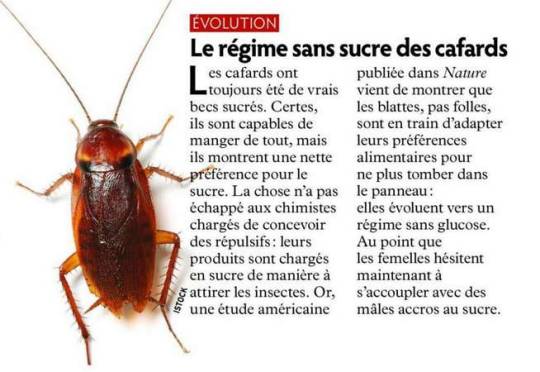
Another amazing thing I wanted to talk about is how cockroaches manage to defend themselves against predators like the emerald wasps. They turn around and hit it with their rear paws, just like on the video ↓
https://figshare.com/articles/dataset/Supplementary_Material_for_How_Not_to_Be_Turned_into_a_Zombie/7270961?file=13397696
4/ ember wood cockroach (Ectobius vittiventris)
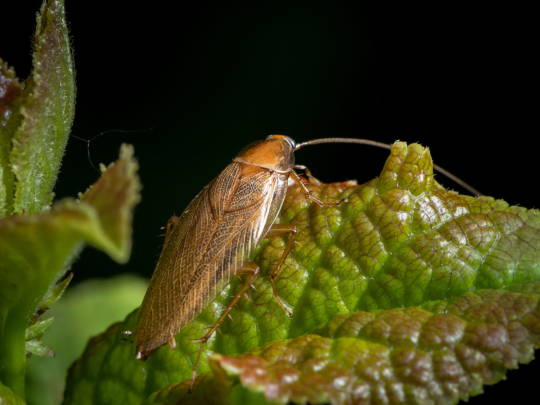
This one is in my top 5 for emotional reasons 🥺. There are plenty of them in my garden so I can observe them and interact better with them than any other species of cockroaches. I played with one of them once.
Have you ever see a cockroach pooping? Because I do. One of this bad boi pooped on me once. I had a wood roach resting on my arm when suddenly it started walking around. When it stoped it bended its body and I was like "woah! Cockroaches can sit!?" Until I noticed a black dot....

3/ question mark cockroach (Therea Olegrandjeani)

Ok I'll be honest with you. I don't really have anything to say about them other than are very pretty...
But did you know the dots on its back only appear after the last moult? The juveniles are all dark brown before becoming adults.
https://youtu.be/Y1eiszrsWto?si=LiaGahUOEi63PQng
2/ Madagascar hissing cockroach (Gromphadorhina portentosa)
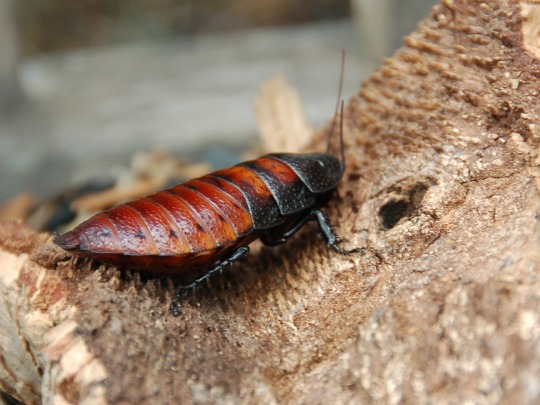
They are call like that because of the hissing sound they make to frighten predators since they are a wingless species.
The females of this species carry their ootheca (sort of bag with eggs in it some female cockroaches and mantis carry at the end of their abdomen) internally, making the eggs hatching inside the mother (this is called ovoviviparity). The nymphs stay close to their parents for protection and to be fed.
1/ Emerald Cockroach (Corydidarum magnifica)


Of course, the emerald cockroach would be the first on list! Look at them, they are beautiful! You can easily recognise the male from the female since he is the one who got wings. One thing I love about cockroaches is when the males and females look drastically different from each other.
Just like the hissing roach, this species too have its nymphs formed inside the mother for 4 to 6 months. Once born, they will hide under their mother to be fed and protected. Then, the nymphs will explore their environment while staying close to their parents, most of the time they will hide under the mother but it's not rare to see them hiding under males.
https://youtu.be/KzRJhpowB4A?si=N9gvkPysLbvW0Ard
(The video is in french but you can just read the pinned comment which have an English citation about what's happening)
#i hope everything make sense English is not my first language#entomology#cockroach#dreaming ask#american cockroach#ember wood cockroach#question mark cockroach#hissing cockroach#emerald cockroach#cockroaches are the best insects in the world and nothing can change my mind
22 notes
·
View notes
Text
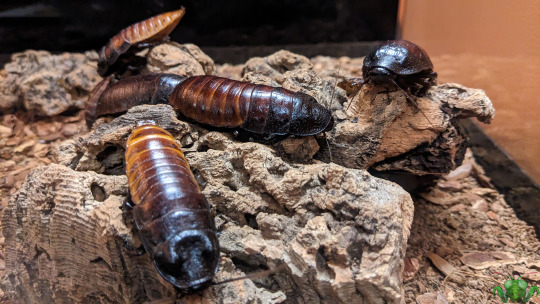
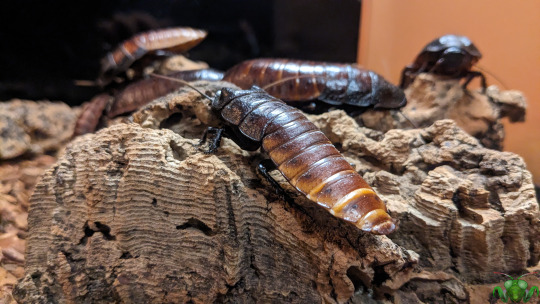
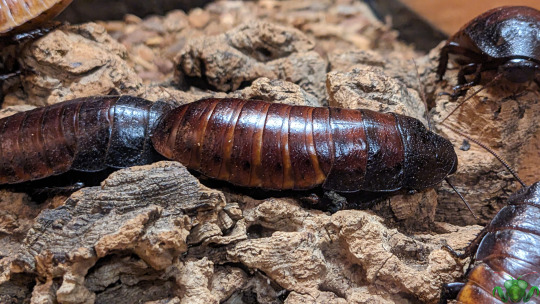


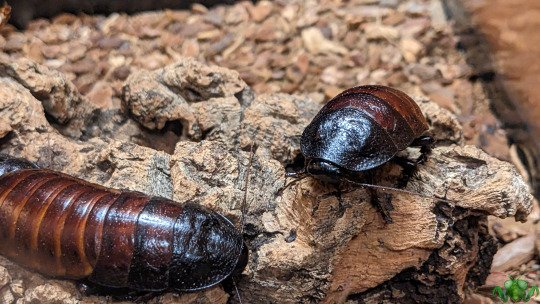
Madagascar Hissing Cockroach - Gromphadorhina portentosa
With this set of insect images, all pictures from the ROM for the year 2023 are proudly displayed on this blog for you to enjoy. I've already gone at length discussing these feisty beans and their habits, behaviors and routines. While many onlookers may not see these armored insects as appealing, I take great knowing the role that they have within their own ecosystems and the opportunities they provide for eager minds to learn, whether as pets or in exhibits. It could be worse if you're not a Roach fan: as this specie lacks wings, it can't suddenly startle you by becoming airborne and (unintentionally) buzzing towards you. They can run rather quickly, however! Having visited this exhibit many times before, it would be a benefit to have additional information displayed regarding these curious insects.
Though simple, there's so much to learn about them, and many myths that can be dispelled so as to not treat all Roaches as "dirty insects" (admittedly these species does consume debris and rotting material as they are decomposers by nature). An interactive series of hissing samples would provide a lot of insight into how they interact and communicate with each other and the other creatures they encounter. Perhaps hearing it live is more authentic, but in a carefully curated environment such as this one, agitating the exhibit denizens for spectacle wouldn't be the best idea. Besides, a sudden hiss from such a small creature is quite startling the first time, especially if you're not expected it. It's up to the Cockroach to determine how aggressively it will press air from its spiracles.
Pictures were taken on December 19, 2023 with a Google Pixel 4. Please go and visit the bugs.
#jonny’s insect catalogue#ontario insect#roach#madagascar hissing cockroach#cockroach#blattodea#insect#ROM insect#royal ontario museum#insect exhibit#toronto#december2023#2023#nature#entomology#invertebrates
24 notes
·
View notes
Text
November 29th, 2023

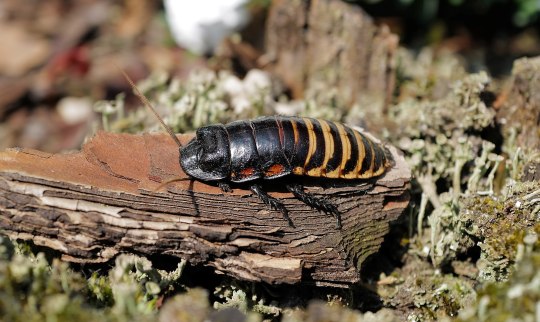
Hissing Cockroach (Gromphadorhina portentosa)
Distribution: Native only to the island of Madagascar, to the east of the African continent.
Habitat: Prefer dark, moist environments; in the wild, often found inside rotting logs.
Diet: Opportunistic; in natural environments, they usually feed on ripened fruit that have fallen on the forest floor. In captivity, they can feed on dry, processed pet food and various fruits.
Description: Hissing cockroaches have earned their common name from a hiss-like sound they produce to ward off potential predators. Often compared to the sound of a rainstick or rattlesnake, these insects hiss by forcefully expelling air from specialized openings on their abdomen. Apart from scaring off predators, males may also hiss to attract females and to challenge other males.
Due to their ease of care and easygoing nature, hissing cockroaches are popular in laboratories, classrooms and as pets. Due to their tropical environment, their enclosures must be kept warm, and they have to be given ample shelters to hide during the day, as this species dark habitats. In captivity, they can live up to five years.
(Images by Klaus Rudloff and Mark Benecke)
9 notes
·
View notes
Text
Back to basics || ep 1
Gromphadorhina portentosa (Madagascan hissing cockroach)

I would argue that hissing roaches are the most well know roaches in the exotic pet community. They are know for their loud hiss (surprising, right?) and are very common pets for beginners and collectors alike. They are great pets for kids as they are very hardy and easy to keep.
This species does not have eggs and gives birth to live young, they can be told apart by looking at the horns on their heads or by looking at their undersides.
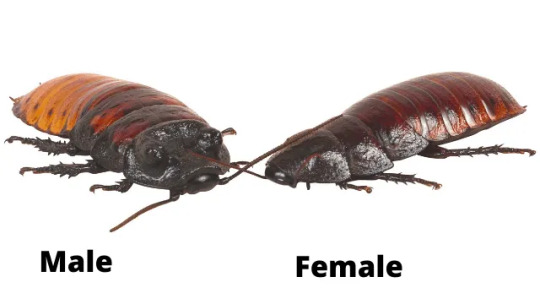
I would argue that these are the best choice if you're looking to get into insects or roaches. I've added some resources below if youre interested in keeping them.
Youtube resources
@the.millipede on tiktok
@luccasbiohub on tiktok
4 notes
·
View notes
Text
I've been making posts about my spiders but keeping them efficiently requires from me to maintain some different "pets" as well.
Somehow I never posted anything about those... Wonder why...
Here they are:
Shelfordella lateralis, Turkistan roaches, "Turks" or Red Runners:

Those are the smallest feeders I usually need - the nymphs are about 3mm and adults barely reach 3cm. They're good feeders for small and medium spiders, move a lot and are pretty much harmless. They're not a decent meal for larger spiders however.
Blaptica dubia, Argentinian roach or Dubia roach:

The go-to choice when feeding larger spiders. They reach about 5cm and are considerably fatter than the runners. The only issue is - they're not as fast moving and tend to play dead.
Gromphadorhina portentosa, Madagascar hissing cockroach or Hisser for short.

The largest roaches I use as feeders only occasionally. They're massive and have very hard exoskeleton so only the largest spiders can take them and aren't always eager to do so.
I tend to only use them on special occasions or when I'm leaving my spiders during vacation. Currently I keep only 3 of them and I'll see if I can successfully breed them before they expire.
As you can see all of my roaches are currently enjoying a seasonal treat of pumpkin mush. That way even my spiders can enjoy a seasonal pumpkin-filled cockroaches.
3 notes
·
View notes
Text
@psychopomp-ephrath submitted: She quickly got the hang of hissers, but the others still hesitate.
She proceeded to walk around the entire bin with it.
She's a pro predator!! Good for her, tell her she's perfect. RIP to that poor hisser but spidies gotta eat!
#animals#spider#arachnids#submission#aphonopelma seemanni#madagascar hissing cockroach#Gromphadorhina portentosa#video#cockroach#roach#bug death#predation#tarantula#bugs#costa rican zebra tarantula
177 notes
·
View notes
Text

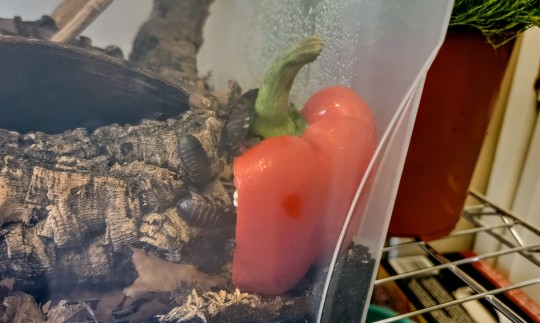
Finally rehoused my hisser colony into a bigger bin 🪳❤️
#madagascar hissing cockroach#hissing cockroach#hissing roaches#gromphadorhina portentosa#invertblr#myroaches#myinverts
4 notes
·
View notes
Text
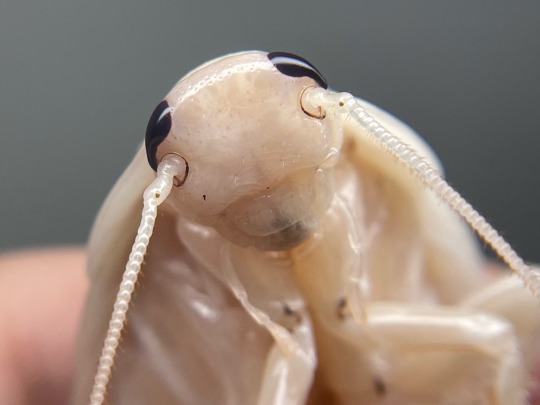
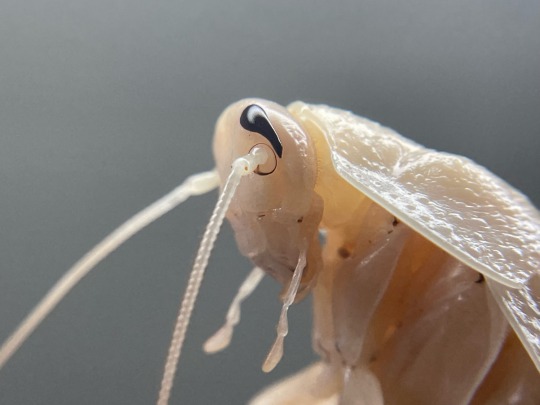

freshly molted Madagascar hissing cockroach. isn’t she lovely?

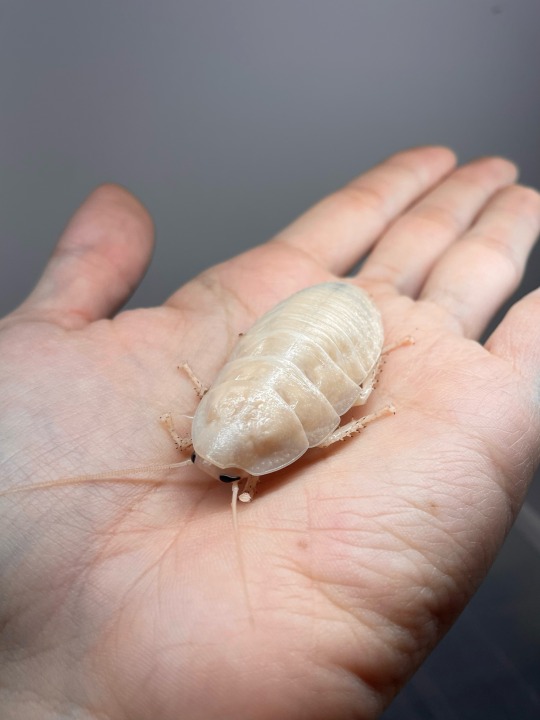
(Gromphadorhina portentosa hybrid)
2K notes
·
View notes
Text
Madagascar Hissing Cockroach Feeding
Flu season is here! Make sure you're getting plenty of vitamin C, just like our colony of Gromphadorhina portentosa (Madagascar hissing cockroaches.
source https://www.youtube.com/watch?v=UPS18Pvw9kY
0 notes